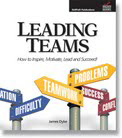A new leadership role presents new opportunities as well as fresh challenges—whether it’s a promotion, shifting into a new department, taking on an existing team as their new boss, or even moving to a completely different organization. In the modern, fast-paced workplace, leadership transitions are becoming more frequent—according to Gartner, one in three leaders is in transition at any point in time! Unfortunately, successful moves are more difficult than ever, even for competent, experienced leaders.
Gartner surveys reveal that 49% of people promoted within their own companies are underperforming up to 18 months after those moves. McKinsey reports that 27% to 46% of executives who transition are regarded as failures or disappointments two years later. These numbers raise serious questions about what organizations are missing in their on-boarding efforts and their leadership training content.
In reflecting on this sobering reality, I am reminded of the advice I found in a Harvard Business Review column published years ago. In it, the author gave the following advice to anyone stepping into a new leadership role:
Your #1 Priority as a New Leader is to NETWORK.
I wrote about this in a previous blogpost. It includes a link to a handy planning form I created to help guide your process of building effective collaborative connections. You can access the post with this link: https://thebossdoctor.net/2020/build-internal-business-alliances/ I highly recommend this resource as a starting point for exploring this topic!
Here’s the important thing to remember: Networking like this is not just a “helpful” strategy. According to the experts, it is essential!
An insightful article in HBR Magazine by Rob Cross, Greg Pryor, and David Sylvester (November—December 2021 issue) highlighted their findings from researching over 100 companies and interviewing over 160 executives. They came to this astonishing conclusion: Transitioning leaders who were the most productive, innovative, and engaged in their new roles were those who quickly established broad, highly collaborative, and mutually beneficial internal networks.
Sadly, research by others revealed a broad lack of organizational guidance and support for this all-important activity. Individual managers in most companies are largely on their own in developing strong, collaborative relationships with key coworkers. Further, poorly executed leadership transitions have negative impacts that are emotional, material, measurable, and financial. According to Gartner, when a transitioning leader is struggling, their direct reports perform, on average, 15% worse than those who report to a high-performing manager. Worse, those same subordinates are 20% more likely to be disengaged at work or to actually leave the organization! Further, research shows that the productivity of peers also suffers if their work depends on the struggling transitioning employee.
This challenge is only accelerating. More and more organizations are becoming increasingly reliant on highly collaborative business models in order to address the new marketplace demands for ever-greater agility and efficiency. This is the hard truth: Transitioning leaders simply don’t have the luxury of allowing their network connections to form by themselves. Leaders must become much more intentional about investing time, effort, and wisdom to build their networks quickly and collaboratively.
Here’s how experts recommend you do this…
1. Start making broad connections immediately.
As quickly as possible, identify the individuals you will need to collaborate with on a regular basis in order to succeed in your work.
- Learn about their group—how it operates; what pressing concerns it has; any problems or barriers that challenge its efficiency and effectiveness.
- Find out what they need from you and your team, in order to do what they need to do; and to do what you need them to do.
- Get to know the key individuals personally—by name; background; driving motivations; interests; hobbies.
- Ask them about other key individuals in the organization who might be of help to you in various ways…
Colleagues in other business units, corporate functions, levels, and locations who might have a positive or negative impact on the successful implementation of your work
Assistants or gatekeepers of formal leaders, who can help you learn about their boss’s goals, motivations, interests, schedules, and workloads so that it becomes easier to make efficient and effective use of their time and effort
Colleagues in functional and support roles, who can help with successful implementation
Peers, who can be sounding boards and sources of helpful information about corporate culture, opportunities, land-mines, influencers and other key players
Up Close and Personal
In one of my new roles, I joined an organization with the assignment to “rescue” a department that was failing in obvious and alarming ways. I was curious about the history of the department, especially because I was familiar with its remarkable success years earlier. At that time, it was under the leadership of (l’ll call him) “Dave.” Dave had impressive metrics of success during his tenure. He was actually somewhat of a celebrity in the industry. I wondered what he did; how he succeeded; why he ultimately left; and what his successor did or didn’t do in order to carry on after his departure. So I sought the advice of a “rabbi” in the organization—a long-time leader who had been there during Dave’s tenure.
This individual was familiar with the situation, and was an “insider” with the kind of information I needed. I still remember the straightforward assessment he shared with me: “Jim, the thing you have to know about Dave is: He needed an ambulance to follow him around to pick up all the wounded and dead leaders he left in his path.” Dave’s authoritarian style got results in the short term, but ultimately led to his demise in the organization. He was simply impossible to collaborate with, and the organization suffered as a result. Many emerging leaders with great potential simply left. With my rabbi’s advice in hand, I was able to easily demonstrate a much more open, engaging, and inclusive leadership style that quickly led to the kind of measurable success higher-ups were demanding.
I share this story to underscore the value of people in the organization who can supply a new leader with valuable information about the organization—its culture, history, style, leadership, strengths, and weaknesses.
2. Build influence with other leaders.
You want to become a leader that other people in the organization actually LIKE. (I know. That sounds so superficial and almost juvenile!) But so much of your collaborative success depends on your “personal” power—your influence as a person—not the “positional” power of your authority in the organization. How, exactly, do you become a “likeable” person? If you have done a good job in your initial step of relationship-building, you are already way ahead of most leaders in the organization:
- Be a good listener, to better understand other people’s needs, goals, and point of view.
- Demonstrate curiosity about your colleagues’ personal and professional interests, what you all have in common.
- Recognize (and respect) the status, authority, value, and contributions of others.
- Show your willingness to support your colleagues and contribute to their success.
- Be willing to listen to other people’s ideas and receive feedback without defensiveness.
- Adjust your style and approach to fit the culture of your network.
And this all-important step: Work towards creating mutual successes that benefit others in your network as much as they benefit you.
If you want even more, simple (but powerful) ways to become influential, download my special paper on The Top 10 Habits of Highly Likeable People. You’ll find it with this link: https://thebossdoctor.net/wp-content/uploads/2022/03/LikeableArticle.pdf
3. Identify where and how you add value to the organization and who can help you add even more.
Here’s how authors Cross, Pryor, and Sylvester describe this important aspect:
“Transitions invariably create skills gaps… Most of us either fail to see them or try to bluff our way through. But fast movers get clarity on their value add and then work to improve in the areas where they’re weak or find people whose knowledge and skills fill the gaps—which is often a faster and more effective way to come up to speed.”
Up Close and Personal
In one organization I joined, I found myself in yet another “turnaround” situation. What helped me gain a quick and helpful perspective was my actual job interview. The CEO and Exec were crystal clear about what they needed from me. It was also apparent what I could bring to my position AND to the organization that would be of help to continued growth and overall success. When I embarked on an ambitious project to create video-based training content, I realized immediately that I needed to connect with media experts and partners who could bring me up to speed on the technical aspects of the project, and do so quickly and effectively. The successful results I achieved were every bit a product of their contribution as mine.
No matter what your strengths are, you will always find gaps. This becomes increasingly true as you climb the corporate ladder! Highly effective leaders seek out alliances with others in the organization who can fill those gaps and add value to their ideas, their projects, their challenges, and their impact.
The authors put it this way:
“Fast movers… tap their networks for both ideation and implementation—that is, they seek help from innovators across the organization who can offer novel solutions to pressing problems and from influencers who can help execute on, spread, and sell those ideas.”
Start by identifying the different types of people in the organization who can help or hurt:
Hubs—Leaders who already have a large informal network of people with whom they share ideas and support.
Spanners—Colleagues who are good at bridging organizational silos, locations, and sub-groups.
Dynamos—People with positive energy, enthusiasm, and passion who can build broader influence and support by engaging others across the organization.
Inertials—Individuals who, by nature, are resistant to change and innovation—people whose points-of-view and strong opinions must be addressed early-on in order to improve ideas and gain support.
4. Build relationships with people who can provide emotional and personal support as well as professional support.
ALL successful leaders (not just transitioning ones!) develop a strong network of people they lean on for emotional and personal support. These are trusted individuals that leaders can go to for advice, feedback, and venting. Here are some suggestions:
Peer Co-Mentors—These are people in your industry who also work at your level (not necessarily in your organization)—people you trust to give you honest opinions and views (especially about YOU!). Keep in mind—this is a mutual relationship. Expect them to seek the same honest input from you about them. My advice: Find these people early in your career!
Industry Professionals—These are people in your industry at other organizations and at various levels. Professional organizations and associations are helpful places to find these people and build these relationships. There are other helpful people you often find in such organizations:
Role Models—Professional associations often give successful leaders the kind of exposure and visibility that allows them to share their experience, wisdom, and advice more broadly among emerging leaders in their industry.
Mentors—More and more organizations are investing in strategically led mentoring initiatives. Mentors can accelerate the learning process of emerging leaders, and can also supply badly-needed perspective and wisdom for leaders facing new challenges.
Colleagues—Yes, individuals within the organization with proven skill, wisdom, insight, and leadership. These are people that transitioning leaders can reach out to—for a broader perspective, helpful ideas, and practical approaches. One additional reminder: You may have an extremely helpful “colleague” right under your nose—one of your own subordinates! Don’t overlook the value of your own team members, simply because they report to you.
All of these are examples of the noteworthy insight of Ken Blanchard:
None of us is as smart as all of us.
If all of this information seems a bit overwhelming, keep this in mind: You don’t have to build a big network, just a strategic one. Some of the most effective fast-rising leaders have made it a point to focus on connecting with a small, but highly-helpful group of people. You can do the same!
If you would like some help in identifying and connecting with your highly-helpful group, we can help! Our executive coaching services can equip you for masterful networking and collaboration. We’re just an email away!
And if you want to do better for your organization’s transitioning leaders, we can help you as well…with…
- Strategies that pair newcomers with veteran employees as “sponsors”
- On-boarding programs that are structured for the entire first year
- Leadership training that intentionally spans levels, departments, and silos
- Mentoring and coaching initiatives to flatten the learning curve and share best practices
Until next time… Yours for better leaders and better organizations,
Dr. Jim Dyke – “The Boss Doctor” ™ helping you to BE a better boss and to HAVE a better boss!








